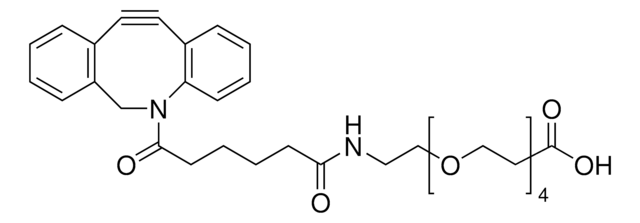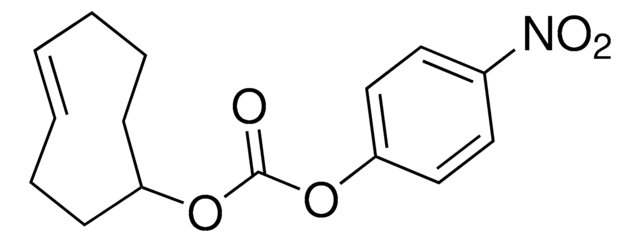761982
Dibenzocyclooctyne-PEG4-alcohol
for Copper-free Click Chemistry
Sinonimo/i:
Polyethylene glycol, DBCO-PEG4-OH
About This Item
Prodotti consigliati
Forma fisica
solid
Impiego in reazioni chimiche
reaction type: click chemistry
reagent type: linker
Punto di fusione
50-60 °C
Gruppo funzionale
hydroxyl
Temperatura di conservazione
−20°C
Stringa SMILE
O=C(CCCCC(NCCOCCOCCOCCOCCO)=O)N1CC2=C(C=CC=C2)C#CC3=C1C=CC=C3
InChI
1S/C29H36N2O6/c32-16-18-36-20-22-37-21-19-35-17-15-30-28(33)11-5-6-12-29(34)31-23-26-9-2-1-7-24(26)13-14-25-8-3-4-10-27(25)31/h1-4,7-10,32H,5-6,11-12,15-23H2,(H,30,33)
ZZXWONCQAFVJHM-UHFFFAOYSA-N
Applicazioni
Codice della classe di stoccaggio
11 - Combustible Solids
Classe di pericolosità dell'acqua (WGK)
WGK 3
Punto d’infiammabilità (°F)
Not applicable
Punto d’infiammabilità (°C)
Not applicable
Certificati d'analisi (COA)
Cerca il Certificati d'analisi (COA) digitando il numero di lotto/batch corrispondente. I numeri di lotto o di batch sono stampati sull'etichetta dei prodotti dopo la parola ‘Lotto’ o ‘Batch’.
Possiedi già questo prodotto?
I documenti relativi ai prodotti acquistati recentemente sono disponibili nell’Archivio dei documenti.
I clienti hanno visto anche
Articoli
Copper-free click chemistry is an alternative approach to click chemistry that proceeds at a lower activation barrier and is free of cytotoxic transition metal catalysts.
Il team dei nostri ricercatori vanta grande esperienza in tutte le aree della ricerca quali Life Science, scienza dei materiali, sintesi chimica, cromatografia, discipline analitiche, ecc..
Contatta l'Assistenza Tecnica.










![N-[(1R,8S,9s)-Bicyclo[6.1.0]non-4-yn-9-ylmethyloxycarbonyl]-1,8-diamino-3,6-dioxaoctane for Copper-free Click Chemistry](/deepweb/assets/sigmaaldrich/product/structures/294/853/c5e47d84-5aee-4797-aa24-604f291171cc/640/c5e47d84-5aee-4797-aa24-604f291171cc.png)


![(1R,8S,9s)-Bicyclo[6.1.0]non-4-yn-9-ylmethanol for Copper-free Click Chemistry](/deepweb/assets/sigmaaldrich/product/structures/171/632/0556139a-2db5-4678-a6ec-a26a693fd574/640/0556139a-2db5-4678-a6ec-a26a693fd574.png)


